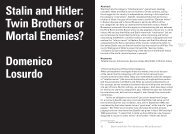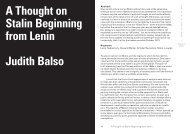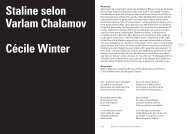Reflections on the Meaning of Stalinism Paul Le Blanc
blanc
blanc
Create successful ePaper yourself
Turn your PDF publications into a flip-book with our unique Google optimized e-Paper software.
<strong>the</strong> “party maximum” – <strong>the</strong> ceiling imposed <strong>on</strong> <strong>the</strong> earnings <strong>of</strong> Party<br />
members. At first this was very low – an <strong>of</strong>ficial was paid scarcely more<br />
than a manual worker, though certain advantages went with a resp<strong>on</strong>sible<br />
job. <strong>Le</strong>nin set <strong>the</strong> t<strong>on</strong>e by refusing an extra kopeck or slice <strong>of</strong> bread.<br />
Later <strong>the</strong> ceiling was raised, more m<strong>on</strong>ey for expenses was allowed and<br />
it was possible to earn extra <strong>on</strong> <strong>the</strong> side by writing. Some people slipped<br />
into bourgeois ways, but this was frowned <strong>on</strong> as a sign <strong>of</strong> “degenerati<strong>on</strong>.”<br />
NEP struck a fur<strong>the</strong>r blow at <strong>the</strong> traditi<strong>on</strong>, but as l<strong>on</strong>g as <strong>Le</strong>nin was alive<br />
something more than lip service was paid to it. A man might earn 120<br />
roubles a m<strong>on</strong>th and use <strong>the</strong> special shops and restaurants opened for<br />
<strong>the</strong> privileged, but he was still not completely cut <strong>of</strong>f from <strong>the</strong> rank and<br />
file <strong>of</strong> <strong>the</strong> Party or from <strong>the</strong> masses. The change came with Stalin and<br />
his high material rewards to his supporters. In preparati<strong>on</strong> for <strong>the</strong> final<br />
struggle with <strong>the</strong> Oppositi<strong>on</strong> [in 1926-27], <strong>the</strong> struggle against privilege<br />
was finally given up. 25<br />
In 1932, as workers’ protests were being fiercely repressed,<br />
according to Berger, “fairly high local <strong>of</strong>ficials were punished as well<br />
as <strong>the</strong> strikers.” The reas<strong>on</strong> was that, outraged by <strong>the</strong> workers’ plight,<br />
“some party <strong>of</strong>ficials were not satisfied with protesting to Moscow but<br />
insisted <strong>on</strong> sharing <strong>the</strong>se c<strong>on</strong>diti<strong>on</strong>s <strong>the</strong>mselves. They and <strong>the</strong>ir wives<br />
boycotted <strong>the</strong> special shops, wore workers’ clo<strong>the</strong>s and stood in <strong>the</strong> food<br />
queues.” Berger recounts <strong>the</strong> explanati<strong>on</strong> by <strong>on</strong>e <strong>of</strong> Stalin’s lieutenants,<br />
Lazar Kaganovich, for <strong>the</strong>ir punishment: “<strong>the</strong> use <strong>of</strong> special shops by <strong>the</strong><br />
privileged was party policy – to boycott <strong>the</strong>m was <strong>the</strong>refore aggressi<strong>on</strong><br />
against <strong>the</strong> Government. It was a sign <strong>of</strong> aping <strong>the</strong> workers and following<br />
<strong>the</strong>ir lead – a dangerously subversive attitude.” In his incisive study<br />
The Birth <strong>of</strong> <strong>Stalinism</strong>, Michel Reiman emphasizes that “while political<br />
terror played an important part, <strong>the</strong> real core <strong>of</strong> <strong>Stalinism</strong> … was social<br />
terror, <strong>the</strong> most brutal and violent treatment <strong>of</strong> very wide sectors <strong>of</strong> <strong>the</strong><br />
populati<strong>on</strong>, <strong>the</strong> subjecti<strong>on</strong> <strong>of</strong> milli<strong>on</strong>s to exploitati<strong>on</strong> and oppressi<strong>on</strong> <strong>of</strong><br />
an absolutely excepti<strong>on</strong>al magnitude and intensity.” The implementati<strong>on</strong><br />
<strong>of</strong> this “revoluti<strong>on</strong> from above” required a ruling stratum “separated from<br />
<strong>the</strong> people and hostilely disposed toward it” – and so “elements within<br />
<strong>the</strong> ruling stratum that tried to represent or even c<strong>on</strong>sider <strong>the</strong> interests <strong>of</strong><br />
<strong>the</strong> people were suppressed.” 26<br />
Repressi<strong>on</strong> was nothing new to Russia. Under <strong>the</strong> old<br />
Tsarist order pris<strong>on</strong> and labor camps had existed with an overall<br />
populati<strong>on</strong> <strong>of</strong> 30,000 to 50,000 pris<strong>on</strong>ers. In <strong>the</strong> era <strong>of</strong> <strong>Le</strong>nin’s government,<br />
and throughout <strong>the</strong> 1920s, <strong>the</strong> camps c<strong>on</strong>tinued to exist, averaging<br />
about 30,000 inmates. But Stalin’s “revoluti<strong>on</strong> from above” – <strong>the</strong> forced<br />
C<br />
R<br />
I<br />
S<br />
I<br />
S<br />
&<br />
C<br />
R<br />
I<br />
T<br />
I<br />
Q<br />
U<br />
E<br />
/<br />
Volume 3 /<br />
Issue 1<br />
collectivizati<strong>on</strong> <strong>of</strong> land and rapid industrializati<strong>on</strong> – increased <strong>the</strong><br />
populati<strong>on</strong> <strong>of</strong> <strong>the</strong> Gulag to hundreds <strong>of</strong> thousands in <strong>the</strong> early 1930s,<br />
soaring to at least 1.3 milli<strong>on</strong> by 1937. Death helped keep <strong>the</strong> number<br />
<strong>of</strong> pris<strong>on</strong>ers down. “In 1930-40, at least 726,000 people were shot, most<br />
<strong>of</strong> <strong>the</strong>m in 1937-38,” comments historian Oleg Khlevniuk. “Executi<strong>on</strong>s,<br />
al<strong>on</strong>g with <strong>the</strong> high mortality rate during investigati<strong>on</strong> and en route to and<br />
within pris<strong>on</strong>s and camps, reduced <strong>the</strong> ultimate number <strong>of</strong> inmates.” It<br />
has been estimated that 936,766 additi<strong>on</strong>al pris<strong>on</strong>ers died in <strong>the</strong> camps<br />
between 1934 and 1947. 27<br />
The foremost victims <strong>of</strong> <strong>the</strong> Stalin purges were Communists<br />
who vocally, quietly, or even potentially were opp<strong>on</strong>ents <strong>of</strong> <strong>the</strong> policies<br />
associated with <strong>the</strong> “revoluti<strong>on</strong> from above.” These were <strong>the</strong> primary<br />
target <strong>of</strong> <strong>the</strong> famous purges and public trials <strong>of</strong> <strong>the</strong> late 1930s. Am<strong>on</strong>g <strong>the</strong><br />
most natural <strong>of</strong> <strong>the</strong>se victims were many who had at <strong>on</strong>e point or ano<strong>the</strong>r<br />
had some c<strong>on</strong>necti<strong>on</strong> with <strong>the</strong> <strong>Le</strong>ft Oppositi<strong>on</strong> associated with <strong>Le</strong><strong>on</strong><br />
Trotsky, as well as those around Gregory Zinoviev and <strong>Le</strong>v Kamenev, <strong>the</strong><br />
Right Oppositi<strong>on</strong> associated with Nikolai Bukharin, Alexei Rykov, and<br />
Mikhail Tomsky, not to menti<strong>on</strong> <strong>the</strong> various o<strong>the</strong>r oppositi<strong>on</strong>al currents<br />
that had cropped up from time to time. This accounted for <strong>the</strong> most<br />
famous <strong>of</strong> <strong>the</strong> executed victims – Zinoviev, Kamenev, Bukharin, Rykov,<br />
and many o<strong>the</strong>rs. At show trials in 1936, 1937, and 1938, <strong>the</strong>y were forced<br />
to make false c<strong>on</strong>fessi<strong>on</strong>s testifying to <strong>the</strong>ir counter-revoluti<strong>on</strong>ary guilt<br />
and requesting that <strong>the</strong>y be shot. Such results were generally <strong>the</strong> result<br />
<strong>of</strong> physical and psychological torture and threats against <strong>the</strong> victims’<br />
families. In fact, such family members generally ended up disappearing<br />
into <strong>the</strong> pris<strong>on</strong>s and camps as well. 28<br />
In fact, 60 percent <strong>of</strong> Communist Party members <strong>of</strong> <strong>the</strong> in 1933<br />
were expelled by 1939. Stalin targeted many who had supported him<br />
against <strong>the</strong> oppositi<strong>on</strong>ists. In 1934, at <strong>the</strong> Seventeenth Communist Party<br />
C<strong>on</strong>gress was overwhelmingly Stalinist (known as “<strong>the</strong> C<strong>on</strong>gress <strong>of</strong> <strong>the</strong><br />
Victors”), with Stalin exulting that “<strong>the</strong> party today is united as it never<br />
has been before.” Yet <strong>of</strong> <strong>the</strong> C<strong>on</strong>gress’s 1,966 delegates, 1,108 were<br />
arrested as “counter-revoluti<strong>on</strong>aries” over <strong>the</strong> next several years – and<br />
78 percent <strong>of</strong> <strong>the</strong> Central Committee members elected at that C<strong>on</strong>gress<br />
were arrested and shot, mostly in 1937-38. Well over two hundred<br />
thousand were kicked out <strong>of</strong> <strong>the</strong> party, many <strong>of</strong> whom were so<strong>on</strong> shipped<br />
<strong>of</strong>f to <strong>the</strong> Gulag. While in 1934, 81 percent <strong>of</strong> <strong>the</strong> party elite had been<br />
Communists before 1921, by 1939 this was true <strong>of</strong> <strong>on</strong>ly 19 percent. 29<br />
Many <strong>of</strong> <strong>the</strong> victims <strong>of</strong> <strong>the</strong> purges came from <strong>the</strong> middle layers <strong>of</strong><br />
<strong>the</strong> party and state bureaucracy. Some scholars suggest that Stalin<br />
C<br />
R<br />
I<br />
S<br />
I<br />
S<br />
&<br />
C<br />
R<br />
I<br />
T<br />
I<br />
Q<br />
U<br />
E<br />
/<br />
Volume 3 /<br />
Issue 1<br />
27 Dallin and Nicolaevsky 1947, pp. 191; Khlevniuk 2004, pp. 304-306.<br />
25 Berger 1971, pp. 89-90.<br />
28 Khlevniuk 2004; Medvedev 1989; <strong>Le</strong> <strong>Blanc</strong> 2015b, pp. 110-125.<br />
26 Reiman 1987, pp. 118, 119.<br />
29 <strong>Le</strong> <strong>Blanc</strong> 2006, 121; Suny 1998, pp. 261-268; Medvedev 1989, pp. 327-455.<br />
94 <str<strong>on</strong>g>Reflecti<strong>on</strong>s</str<strong>on</strong>g> <strong>on</strong> <strong>the</strong> <strong>Meaning</strong> <strong>of</strong> <strong>Stalinism</strong><br />
95<br />
<str<strong>on</strong>g>Reflecti<strong>on</strong>s</str<strong>on</strong>g> <strong>on</strong> <strong>the</strong> <strong>Meaning</strong> <strong>of</strong> <strong>Stalinism</strong>






